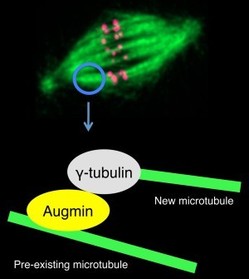A newly characterized protein complex called augmin has a vital role in preparing cells for division

Fig. 1: The augmin and γ-tubulin protein complexes work cooperatively to amplify the number of microtubules during cell division (green; microtubules, magenta; kinetochore).
c 2010 Nagoya University
When cells divide, a process known as mitosis, the replicated chromosomes separate into the daughter cells. This process is driven by the mitotic spindle -- a spontaneously assembling structure consisting of many microtubules.
The microtubules themselves are constructed from chains of two small globular proteins called α- and β-tubulin. Another member of the tubulin family, γ-tubulin, is believed to be important for nucleating microtubule growth within the main microtubule-organizing center of the cell, called the centrosome. However, γ-tubulin is localized throughout the mitotic spindle, suggesting the possibility that it could dock onto existing microtubules, thereby nucleating further microtubules within the spindle, independent of the centrosome.
Working with the fruitfly Drosophila melanogaster, a research team led by Gohta Goshima from the Nagoya University Institute for Advanced Research previously1 identified five proteins (Dgt2 to Dgt6) that are involved in docking γ-tubulin onto spindle microtubules rather than the centrosome itself.
Now, Goshima and his colleagues in the USA and Germany have shown2 that these proteins interact with each other to form a stable complex within the cell. To study the specific function of these proteins, the team used a technique called RNA interference to block the cellular expression of each Dgt protein.
"The generation of spindle microtubules was substantially reduced in cells lacking one or more of these proteins," says Goshima. "It appears that the function of the Dgt complex is to augment microtubule numbers, and for this reason we have called it 'augmin'."
The researchers noticed that the cells in which spindle microtubule generation was reduced by blocking augmin expression, and which were also lacking functional centrosomes, exhibited severe defects in mitotic spindle formation that were clearly visible under the microscope.
These defects included substantially reduced fiber formation at the kinetochore (a structure to which spindle fibers attach at the chromosome), allowing replicated chromosomes to be pulled apart during mitosis. The researchers also observed misalignment of chromosomes, and severe delays in mitotic progression.
"Our results demonstrate that γ-tubulin works cooperatively with augmin within the mitotic spindle to amplify the number of microtubules during cell division," says Goshima. "Moreover, this process appears to play a vital role in mitotic spindle assembly."
This finding is consistent with previous experiments using this fruitfly, which have shown that formation of the spindle apparatus does not depend on the localization of γ-tubulin solely in the centrosome.
Finally, the researchers have identified a human counterpart to Dgt6 that also localizes to the mitotic spindle. "Our initial experiments suggest that Dgt-dependent microtubule generation plays an equally important role in human cell division," says Goshima.
Affiliated Researchers
The Nagoya University affiliated researchers mentioned in this highlight are from the Institute for Advanced Research
Reference
-
Goshima, G., Wollman, R., Goodwin, S.S., Zhang, N., Scholey, J.M., Vale, R.D. & Stuurman, N. Genes required for mitotic spindle assembly in Drosophila S2 cells. Science 316, 417-421 (2007).
- Goshima, G., Mayer, M., Zhang, N., Stuurman, N. & Vale, R.D. Augmin: a protein complex required for centrosome-independent microtubule generation within the spindle. J. Cell Biol. 181, 421-429 (2009). | article